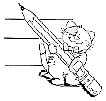Spina Bifida is often considered as a condition which primarily affects the lower half of the body. It is, however, frequently associated with Hydrocephalus which may affect a child's ability to concentrate and learn. Similarly, through compression and stretching of the lower lobes of the brain (Arnold Chiari Malformation), coordination and dexterity of the arms and hands may also be affected.
This is usually not so apparent at birth, and real difficulties may not arise until a child is of a Pre-school age, or in fact not at all.
Initially, it may involve difficulties with small toys like Lego and trouble doing up buttons and zips in dressing. The child may not be keen to sit and play with fine motor toys or experiment with drawing or cutting activities. This kind of aversion to fine motor activity may indicate not only a dislike for but a difficulty in handwriting, later on at school.
Handwriting, however, is much more than a fine motor activity and other factors need to be considered when looking at this skill development. These include:
SEATING POSTURE
WRITING TECHNIQUE(pencil grasp/pressure)

ESTABLISHMENT OF HAND DOMINANCE
INTEREST AND MOTIVATION
It is important to remember that the ultimate aim is for writing to be functionally useful both for the work required in primary school but more importantly for the volume of work provided in high school, and ultimately as a daily skill.
If it is determined that handwriting is not functional then an alternative means of written expression may need to be considered. It is reasonable, though, to assume that the child be allowed more time to develop the basic skills of handwriting before any recommendation for keyboards is made.
Typewriters are also still preferable as an initial tool for the training of keyboard skills, even in this day of computers, because:
- They can be specially/only for the child; no queuing for access
- An immediate input/immediate output is provided
- They are lightweight/portable
- Families can also purchase one
- They have limited functions thereby, decreasing confusion